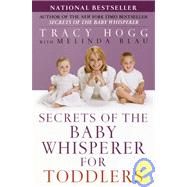
Note: Supplemental materials are not guaranteed with Rental or Used book purchases.
Purchase Benefits
What is included with this book?
| Acknowledgments | p. xiii |
| Introduction | |
| Toddler Whispering: The challenge of toddlerhood and how my philosophy applies | p. 1 |
| Loving the Toddler You Have: Awareness of your child's temperament; how nature and nurture work together | p. 13 |
| H.E.L.P. to the Rescue: A Mantra for Everyday Moments: A strategy to determine when to intervene, and when to encourage independence | p. 41 |
| R&R (Routines and Rituals): Easing the Toddler Tug-of-War: The importance of a structured routine | p. 66 |
| Nappies No More: Striving toward Independence: Issues related to mobility, playing, eating, dressing, and potty | p. 91 |
| Toddler Talk: Maintaining a Dialogue through T.L.C.: Talking with your child as she moves from "Banguage" to language | p. 139 |
| The Real World: Helping Your Child Rehearse Life Skills: Using everyday moments at home to enhance social and emotional readiness | p. 165 |
| Conscious Discipline: Teaching Your Child Self-Control: Setting limits and helping your child manage his emotions | p. 208 |
| Time-Busters: Sleep Deprivation, Separation Difficulties, and Other Problems That Steal Hours from Your Day: Solving chronic behavior problems | p. 242 |
| When Baby Makes Four: Growing Your Family: Preparing for a second child; dealing with siblings; caring for your relationship and taking time to care for yourself | p. 279 |
| Epilogue: Some Final Thoughts | p. 321 |
| Table of Contents provided by Syndetics. All Rights Reserved. |
The New copy of this book will include any supplemental materials advertised. Please check the title of the book to determine if it should include any access cards, study guides, lab manuals, CDs, etc.
The Used, Rental and eBook copies of this book are not guaranteed to include any supplemental materials. Typically, only the book itself is included. This is true even if the title states it includes any access cards, study guides, lab manuals, CDs, etc.
Excerpted from Secrets of the Baby Whisperer for Toddlers by Tracy Hogg, Melinda Blau
All rights reserved by the original copyright owners. Excerpts are provided for display purposes only and may not be reproduced, reprinted or distributed without the written permission of the publisher.